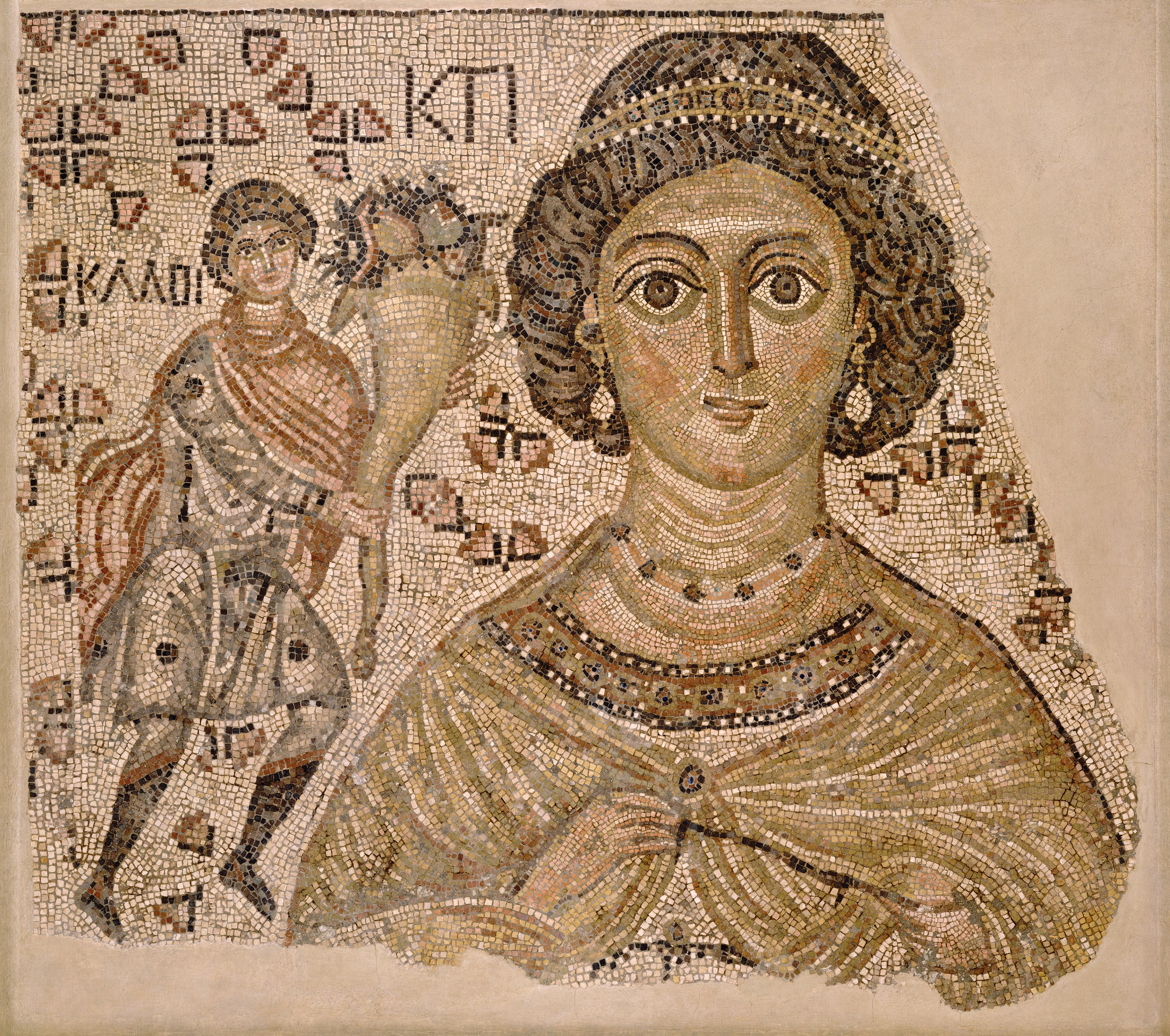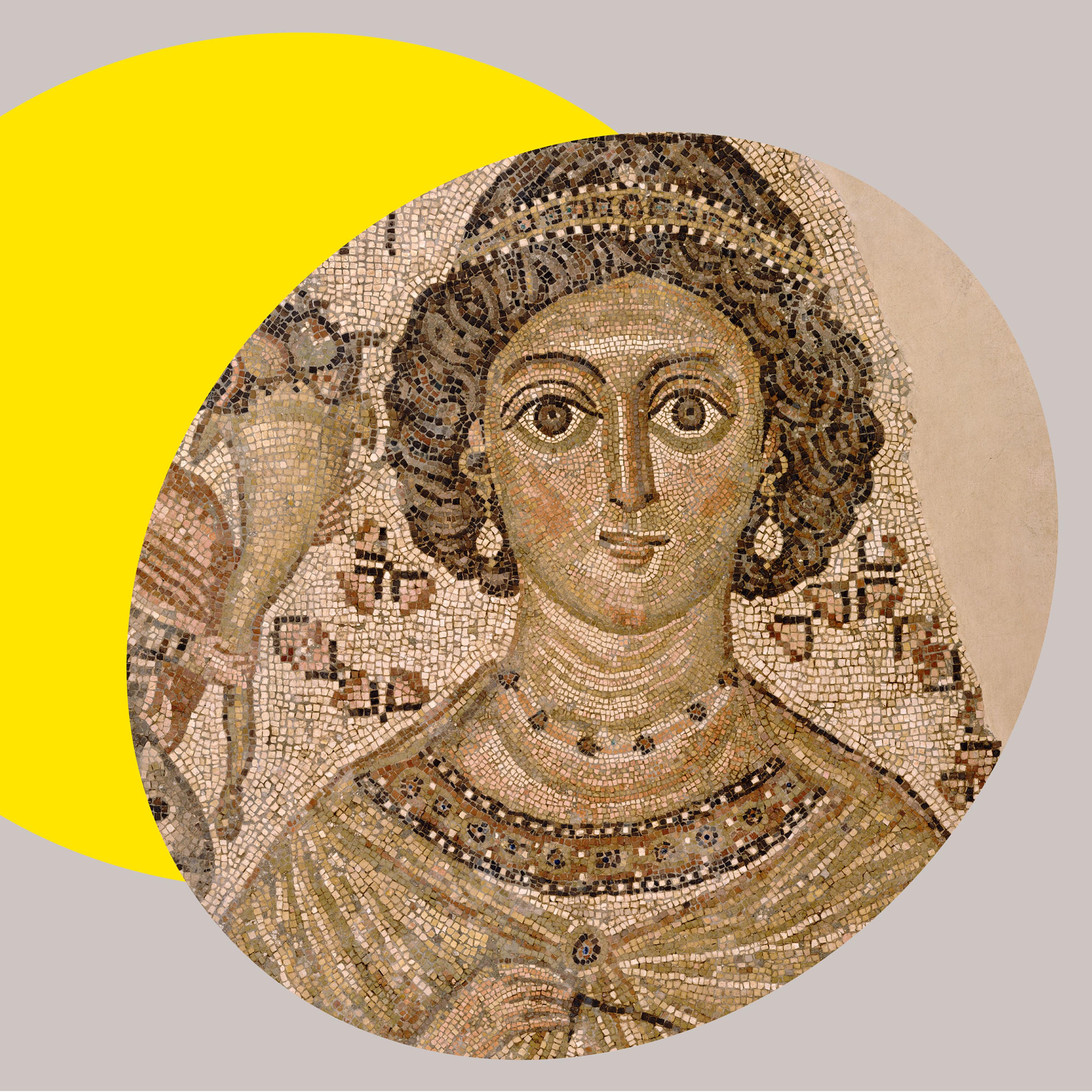Met curator Andrea Myers Achi and art historian Liz James discuss a Byzantine floor mosaic with a Personification of Ktisis (ca. 500–550).
Rethinking Representation
Fragment of a Floor Mosaic with a Personification of Ktisis
Listen to the conversation, learn more about the artwork, and read the transcript below.

Fragment of a Floor Mosaic with a Personification of Ktisis, 500–550, with modern restoration. Byzantine. Marble and glass, 59 1/2 x 78 5/8 x 1 in. (151.1 x 199.7 x 2.5 cm). The Metropolitan Museum of Art, New York, Harris Brisbane Dick Fund and Fletcher Fund, 1998; Purchase, Lila Acheson Wallace Gift, Dodge Fund, and Rogers Fund, 1999 (1998.69; 1999.99)
Although this mosaic—the surviving remnants of a massive floor mosaic—appears to be a portrait of a woman, it in fact depicts an abstract idea called Ktisis, which means “the act of generous donation or foundation.” Made of marble and glass tesserae (small blocks of stone or other colored material), it is an example of the exceptional mosaics created throughout the Early Byzantine world in the first half of the sixth century.
Transcript
ANDREA MYERS ACHI: My name is Andrea Myers Achi. I’m assistant curator in the Department of Medieval Art at The Metropolitan Museum of Art. My curatorial purview is the Byzantine world.
LIZ JAMES: I’m Liz James, I’m professor of art history at the University of Sussex. And I work on Byzantine art and I’m particularly interested in mosaics and images of women.
—
MYERS ACHI: So we’re looking at a mosaic. We see a bust of an elegant lady. Her face is finely modeled in small olive-green and brown stone pieces, called tesserae. The larger tesserae define her abundant hair which frames her face, her dress, and jewelry. She looks like a princess.
Another thing that’s really interesting is that she was originally described as with white and pink stone tesserae and some beige. I think it’s very clear that there’s lots of different colors that were used in order to create her face.
The image to the left depicts an image of a man holding a large basket as if he’s presenting a gift. The monumental scale of the mosaic suggests it was part of the floor of a large room, probably a public building or a wealthy home.
So what drew me to this work is it could be from North Africa. I’ve been thinking a lot about Byzantine African material culture. And North Africans had some of the best mosaicists in the Roman world. And then also I’m interested in the brownness in the representation and how she looks like a southern Mediterranean or Eastern Mediterranean person.
JAMES: Absolutely. A lot of floor mosaics from North Africa, in fact, have survived and been put into Western collections. So, I think that’s a really really interesting point in the context of this mosaic.
MYERS ACHI: And just shows how big and expansive the Byzantine world is, right? So it’s not this idea that all the good Byzantine art is from Constantinople or the center, we’re talking about a huge geographic region that went from Morocco to the Balkans.
And so I’ve been really interested in your work, Liz, in thinking about where the stones were from and the use of local stones. And are the artists depicting a person who is with color, right? Are they intentionally making her non-white? Or is it really based on the local stones that are from the Eastern Mediterranean or North African region and is this just what they had?
JAMES: Yes, and that’s really interesting isn’t it, Andrea, that when you come to make a mosaic you can only make it with the materials that you have. And that will affect the way in which it appears. And it can be really difficult for us now to make any sorts of decisions, or have any real sense of well, does she look like that because that’s what the artist wanted or does she look like that because that was the only thing the artist could do? But she’s so distinctive that I think there must be something deliberate going on there.
That question of the coloring of people in Byzantine art is a really interesting one and how people are colored and what that relates to. It ties up with sort of views as well of masculinity and femininity. The sense that you know, women should have pale skin because they’re delicate indoor creatures. And real men are going to be nice and brown and have beards because actually that’s a sign of their masculinity because they’re outdoors doing lots of hunting, shooting and fishing sort of thing. So it’s interesting that her accomplice appears much paler and yet he’s a male figure.
MYERS ACHI: Oh, I didn’t even think about that in terms of representation. There’s another mosaic out in the world that’s the trio to this and he’s also pale. And so I do wonder if this is intentional. Her hair is also tightly curled and I just think that with the skin and the beautiful curls, for me when I see it is not the typical European. And it’s interesting because people equate Byzantine now as Western art. And I think images like these show that we’re not really in the Western world.
JAMES: I think one of the things it does is shows how complicated a world it was.
MYERS ACHI: You know and we keep talking about her as a woman and we haven’t really gotten into the fact that we’re not actually looking at a person but a personification, an abstract idea called Ktisis. I think people assume this is a picture of someone. And what’s interesting to me about this is that it’s not.
JAMES: Yes, so Ktisis meaning a founding, or settling, a making or creating, or even the world itself can sometimes be a translation of Ktisis. In Greek, it’s a feminine noun so that means that when you try and turn a feminine noun into a personification, a representation of that quality, you have to make it female.
MYERS ACHI: Yeah. This is, you know, 5th, 6th century, deep into the Early Christian period as well. And at the same time we’re also seeing other representations of women. A representation of a woman who’s not wearing these types of attributes, the Virgin Mary, and that tension between this representation of wealth versus saintliness and piety.
JAMES: Yeah. I think it’s a period when it’s really difficult to represent women because women are effectively second-class citizens. They’re not important, they’re not allowed to, you know, really hold roles in government or in the church, or certainly not in the army. So there’s nothing for them in public life.
But with her, you’ve just got, okay, we’ve got this female personification, what do we have to do to make her, I suppose, to make her believable and to make her powerful. Because if she is foundation, if she is the world, if she is good fortune, then she’s bringing power with her, so you’ve got to make her look powerful. And you can’t give it all the symbols that a man can have to be powerful, which would be, you know, a sword or armor, or a scepter if it’s an emperor. You’re left with dressing her up, giving her jewelry.
MYERS ACHI: I wonder if there’s a modern analogy for something like this in the way that people can manipulate an image in order to represent something of status.
JAMES: Yeah, in a way she’s airbrushed, isn’t she?
MYERS ACHI: Yeah.
JAMES: She’s kind of your airbrushed picture of good fortune and good luck. So she needs to be as perfect and as wealthy as you can possibly make her. And we still talk about Lady Luck, yeah? You know Lady Luck is shining on us. And we still have that sense of justice as the female figure.
MYERS ACHI: And even if you think about, like, the Statue of Liberty. I mean that’s the same, like no one’s like, well who is she?
JAMES: Yes. She’s Lady Liberty.
MYERS ACHI: Yeah.
JAMES: So there’s still a little bit of that around that’s sort of there in our consciousness. And that all goes back to people like Ktisis.
###
